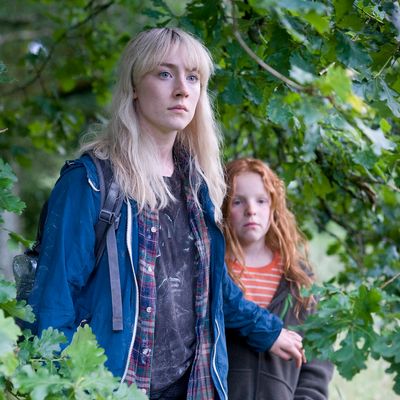
The apocalyptic How I Live Now begins in a deliberately rushed, uncertain fashion. American teen Elizabeth (Saoirse Ronan), who prefers to be called Daisy, arrives in the U.K., amid alarming glimpses of armed soldiers standing guard and breaking-news images of bomb blasts on TV. Something is going on out there, clearly, and we canÔÇÖt quite tell if DaisyÔÇÖs indifference to it comes from being a typically jaded teen, or if this is just the background noise sheÔÇÖs grown up with. Daisy is here to visit her distant cousins, three kids living in a rambling house in the countryside. As she travels out into rural England, even the de rigeur images of bucolic splendor and small country churches pass by in a mad frenzy. We realize thereÔÇÖs no safe harbor out here, not even in the rolling fields of EnglandÔÇÖs green and pleasant land.
The cousinsÔÇÖ mom, ÔÇ£an expert in loony extremists,ÔÇØ is off trying to save the world from Armageddon and so, is largely absent. Left to their own devices, the kids are lackadaisical at first┬áÔÇö they make jokes about World War III and terrorists and fascist regimes. Meanwhile, Daisy and Edmond (George MacKay), the oldest, hunkiest of the bunch, make doe eyes at one another. (DonÔÇÖt worry: A line of dialogue assures us theyÔÇÖre not actually blood relatives.) Then, with a distant rumble and a soft, darkening rain of ash, the war announces itself. We canÔÇÖt quite tell at first if the kids understand exactly what has happened: ÔÇ£WhatÔÇÖs a ÔÇÿnukillerÔÇÖ?ÔÇØ one asks. ÔÇ£ItÔÇÖs just something they say on TV,ÔÇØ another answers. But they all understand that something has changed, perhaps irrevocably┬áÔÇö right before the power goes out and the world goes dark. And suddenly, How I Live Now gains the grim peacefulness it has hitherto lacked.
This tale of teen survival was adapted from Meg RosoffÔÇÖs 2004 novel, and it probably could have easily gone in the more pop direction of something like John MarsdenÔÇÖs Tomorrow series, or even something more sci-fi like The Hunger Games. Such stories can also easily drift into didacticism, but everything remains life-sized and grounded in DaisyÔÇÖs experience, as she journeys through an England being torn asunder by a cataclysmic war. The broader arc of that war┬áÔÇö whatÔÇÖs being fought over, why, and by whom┬áÔÇö is unknown to us. What we see is what Daisy sees. And she sees checkpoints, she sees children getting conscripted, she sees piles of bodies, she sees rapes, she sees work camps┬áÔÇö the human costs of social collapse. But thereÔÇÖs a weirdly dreamlike kick to it all, too. The horrors are universal ones, made surreal by the fact that theyÔÇÖre happening in a contemporary, first world setting. (The film also bears more than a passing resemblance to last yearÔÇÖs Lore, Cate ShortlandÔÇÖs WWII film about a young girl and her family traveling through a Europe in ruins.)
Given the elemental but nonspecific nature of the story, director Kevin Macdonald (Touching the Void, The Last King of Scotland) lets texture and soundscapes do a lot of the heavy lifting here: We can sense in the subtle shifts of light and sound that dramatic things are happening, just beyond the storyÔÇÖs line of vision. ItÔÇÖs an effective, lovely cinematic correlative to the charactersÔÇÖ own helplessness. And itÔÇÖs hard not to tear our eyes away from Ronan, who keeps proving over and over again that she is, easily, her generationÔÇÖs finest actress: See how she turns her usually knowing expression into a glower of teen ambivalence in the filmÔÇÖs early scenes; then watch as she lets the horror of this world sink in, ever so slowly. The film is not without problems┬áÔÇö there are parts where you wish you knew a bit more about what was going on, and parts where you wish you knew less. (The love affair between Daisy and Edmund is particularly weak.) However, between this unusually subtle actress and MacdonaldÔÇÖs visually, sonically astute direction, the film ekes something new out of a spare, glancing story. ThereÔÇÖs a lot left unsaid in How I Live Now┬áÔÇö but itÔÇÖs unsaid with unusual force.


